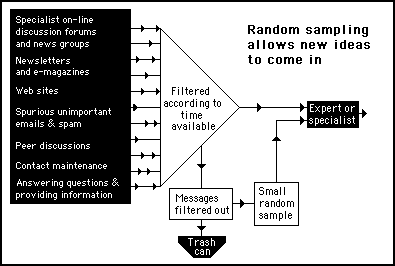
Chapter 15
Communication strategy
The filtering process
All people using the Internet will have a somewhat similar message pattern to that shown in figure 15.1, with one group of messages deemed essential and the rest contributing to an overload that has to be filtered. Priority would be given to the most important messages, but, there can be no hard and fast rules as to what to do with the others that have to be filtered. It is very likely that much of this filtering will be random.
It is interesting to note that researchers working in the field of neuroscience have found that the release of neurotransmitter molecules across synaptic junctions in the brain are not invariably triggered by the electrical spikes that cause them. It seems that neurotransmitter release occurs only randomly when a triggering spike arrives - sometimes averaging one time in ten, perhaps at other times one time in three. It is a random process dependent upon some variable level of probability. This is something like the uncertainty of response you get when you spill coffee on the keyboard of your computer: striking the keys doesn't always have the desired effect.
If the brain is considered to act like a conventional computer, this erratic response to signals passing through the neural networks of the brain seems totally bizarre . However, some mind scientists have suggested that the phenomenon that we call consciousness might have some control over the probabilities of the responses. By raising or lowering the probability of the transfer of molecules (information) across junctions, the brain could be consciously influenced to concentrate upon important issues and not waste time processing unimportant events.
Whether or not this is really how we consciously direct our brains to concentrate on particular issues isn't relevant here, but, such a strategy makes a lot of sense in the context of processing message overloads. Rather than completely ignoring a whole batch of messages, when there isn't time to read them, we could selectively read a random few of them. In other words, provide the opportunity for a few of the surplus messages to be read, which will allow the possibility of ideas and information to arrive from unexpected sources.
It seems that many people glance through a list of unread messages before throwing them away and, if they have time, randomly open a few of them up to glance at their contents. In fact, this is exactly how I picked up this information about the random response of synaptic junctions. Just before consigning several hundred e-mail messages from a variety of e-mail discussion forums to the trash can, I picked out a few that seemed to have an interesting subject line. This casual process uncovered a thread where several scientists were discussing the conscious control of brain activity. Normally, I'd not have time to read through these obscure discussions, but, this chance reading uncovered an interesting way of looking at dealing with message overloads.
Introducing a small element of randomness into the reading of messages can act very much like mutations in an evolutionary process: a chance piece of information may come along that can throw a new light on a problem or lead one to explore a different area of interest. It makes more sense than sticking rigidly to a communication filtering algorithm that locks you into only the sources that you are most familiar with (see figure 15.2).

Figure 15.2
Random sampling of a few surplus messages before trashing them can introduce new ideas and directions
In a local network of information exchanges, such randomising of inputs can prevent the total knowledge of a group getting into a rut. It can act similar to the way in which a random mutation in an individual can lead to a radical change in a biological species. In any strategies based upon genetic algorithms, occasional random inputs are essential and are often the way important breakthroughs are made in the solution to a problem.